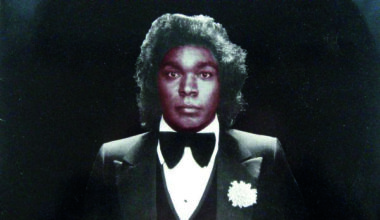Traversing time and space, our wildcard columnist ventures out on some further adventures in audio. This month, Martin Rev…

Hamburg’s Bureau B label are reissuing two classic early solo albums by Martin Rev that reaffirm him as one of last century’s greatest electronic visionaries. Both 1985’s ‘Clouds Of Glory’ and 1991’s ‘Cheyenne’ show that his role as Suicide’s mysterious keyboard magus is just one monumental stop in the ongoing musical journey. It started with him singing doo-wop at school before taking his jazz fixation to the piano, studying under the legendary Lennie Tristano and unveiling his free arkestra at downtown jazz lofts in the run-up to meeting Alan Vega.
Following Vega’s death in 2016, Rev inevitably carries Suicide’s colossal legacy yet continues forging the idiosyncratic path that started with 1977’s self-titled debut and docked nine albums later with 2017’s ‘Demolition 9’; all vital works in a multi-hued canon born from mercurial creativity and restless sonic visualising. Or as Rev puts it, “yearning for joy and the unattainable perfection of artistic ideal”.
I first met Marty on Suicide’s infamous ‘Blood 78’ tour, facing down redneck hostility from nasty hordes waiting for The Clash, and we’d meet up many times again over the years. We became close in 2015 when I was writing my Suicide book, ‘Dream Baby Dream’, and last year when I lost my partner Helen, Marty provided invaluable support like only someone who’d been there could (his lifelong muse Mari passed in 2008). Marty’s quiet cool ying was the polar opposite to Vega’s larger-than-life yang, but it couldn’t have been any other way; Rev created Suicide’s sound, Vega was its confrontational vocal animation.
Marty’s albums allowed him to explore the current stage of his ongoing musical odyssey. After ‘Suicide: Alan Vega And Martin Rev’ was released to indifference in 1980, he told me there wasn’t a lot happening for Suicide, “so we concentrated on solo things”. While Vega worked “on a more high profile level”, Rev pursued his vision of “building an orchestra of pure electronic, more abstract sounds” that manifested as ‘Clouds Of Glory’, the album former manager and Red Star boss Marty Thau had wanted to make with him after the first Suicide album. Recording started at Blank Tapes in February 1981, using the Prophet 5 from the second album sessions on which he also created ‘Cheyenne’.
“I had this very clear visual idea for my next two albums,” explains Marty. “‘Clouds’ was a natural progression from the second Suicide album. I used that Prophet 5 live on shows, which allowed me to get deeper into what could be done with it.”
Rev drew inspiration traveling coast-to-coast across America’s wide-open vistas to visit Mari, who was then living in California.
“I took one of those three-day Greyhound bus excursions; my chance to see America for the first time,” he said. “It was incredible going through the deserts in Texas, Mexico and Arizona. I got this feeling of this American landscape that I had in my mind as a child, but never really saw. This expanse of terrain, landscape and those new sensations greatly influenced my visual concept. They all had that same kind of colour, which was in my mind for a long time. A lot of the time the music was just visual ideas relating to those journeys across America, using sounds I was getting in the new instruments. When I went into the studio I already had a clear idea where to start.”
The album wouldn’t see release until Thau signed it with France’s New Rose label in 1985. The sound is indeed a panoramic expansion of Suicide starkness; gnarly basslines pulsing through ‘Rocking Horse’, ‘Parade’, ‘Dragnet’-evoking ‘Rodeo’ and title track, battered by Rev’s electronic thunder-cracks, video game uproar and stormy washes, spectral melodies peeking like sunlight on the stunning ‘Metatron’. Glistening like a diamond in the molten bass, ‘Whisper’ rears as a gorgeous reinterpretation of Suicide’s ‘Sweetheart’.
‘Cheyenne’ was released in 1991 on the French label Marilyn, but saw Rev reaching into his vaults for the “TV track” instrumentals from Suicide’s second album sessions at the Power Station, given to him by producer Ric Ocasek, now amped up, edited and retitled. I remember getting ‘Cheyenne’ on release and sitting there jaw hanging as familiar backing tracks juddered in to join originals in my DNA. The title track is ‘Touch Me’, ‘Red Sierra’ is ‘Harlem’, ‘Diamonds, Fur Coat, Champagne’ transforms into ‘Prairie Star’ and ‘Buckeye’ resuscitates ‘Fast Money Music’. ‘Sweetheart’ reappears as the gorgeous ‘River Of Tears’, wired early out-take ‘Super Subway Comedian’ becomes ‘Dakota’.
“I thought this reflected another approach,” says Rev. “It’s another sound when you treat it instrumentally. When you work with someone else, it’s like two people working on one painting. When you take the track on its own, it gives you a visual sense of something different. So I had that in my mind for a long time and just kind of had ’em on the shelf. Then the opportunity came with the French label, so I worked those tracks in a way that satisfied me as instrumentals. The pure backing tracks were very close, but their form needed to be arranged a little more. I put them together with some newer tracks.”
These cross-country sound paintings of “the whole American western culture” include ethereal desert serenade ‘Wings Of The Wind’ and the floating drone collage of ‘Little Rock’. Suitably dressed in Mari’s design of a black bronco rider, ‘Cheyenne’ was reissued in 2007 by Mind Expansion with bonus tracks; dreamy doo-wop swoon ‘Coyote’, weird cowboy ditty ‘Pony’ and the mad samba of ‘Durango’ from Suicide’s 1992 ‘Why Be Blue’ sessions. Both unreservedly recommended.
Meanwhile, in the ongoing saga of ‘Windmill’, the various-coloured wax pressings went on Bandcamp pre-order and practically sold out instantly! The Chocolate Hills remix is going down a storm in Orb circles. The 12-inch will coincide with the fourth in Sendelica’s ‘Cromlech Chronicles’ series. This one’s a space-rock killer, setting its launch-pad in the Fillmore West of the late 60s with ‘Lightstar’ before taking off for the stars on tribal cosmic hot-house romp ‘Saturnalia’ and epic Byrds rework ‘9 Miles High’. No band comes close for the intergalactic sphincter-singe.





